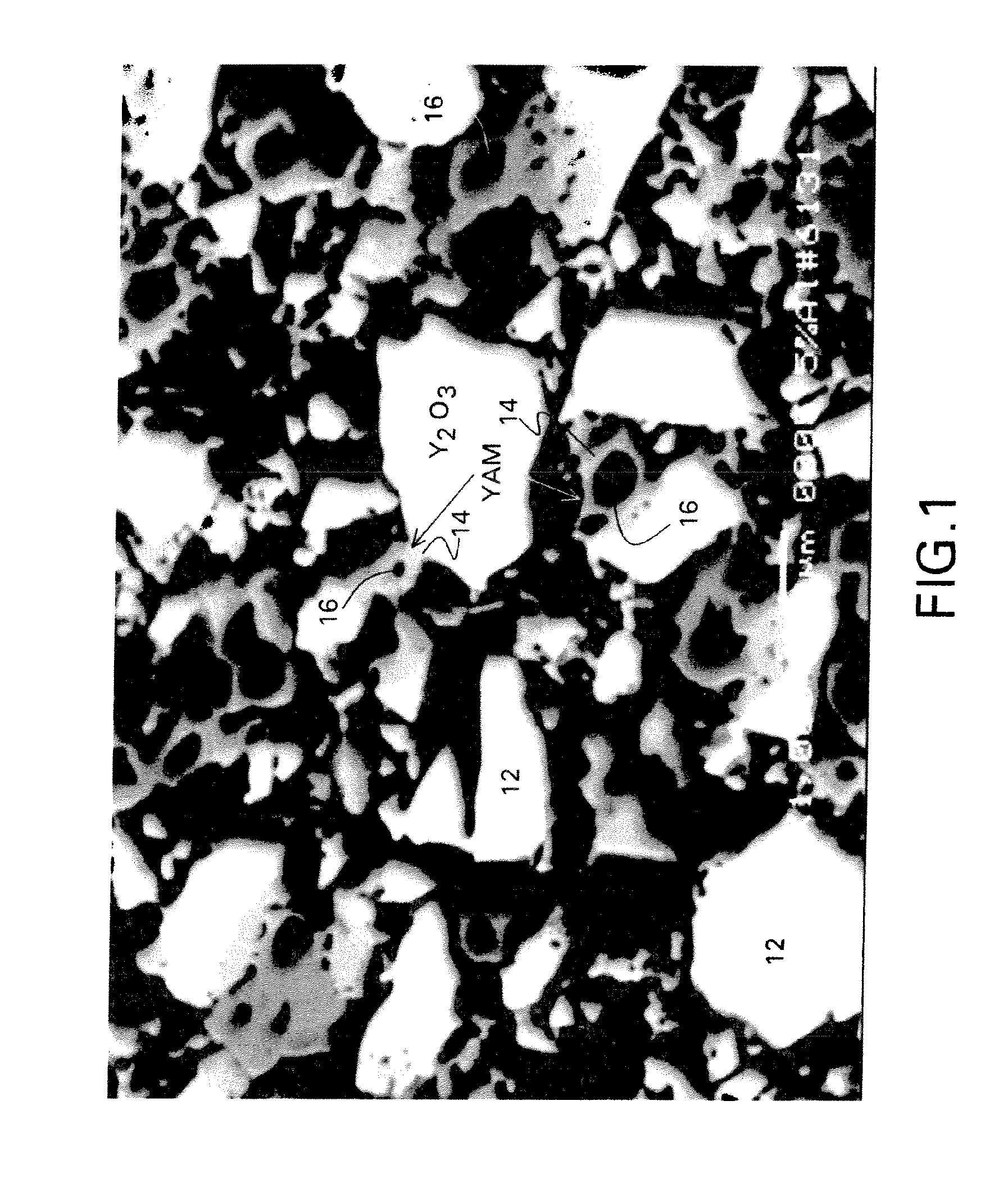Ceramic cores for casting superalloys and refractory metal composites, and related processes
a technology of ceramic cores and superalloys, applied in the field of refractory metal intermetallic composites, can solve the problems of mechanical rupture of casting, difficult to achieve the required dimensional accuracy and stability, and unsatisfactory amount of shrinkage, and achieve the effect of efficient casting
- Summary
- Abstract
- Description
- Claims
- Application Information
AI Technical Summary
Benefits of technology
Problems solved by technology
Method used
Image
Examples
example 1
[0069]A core was prepared by dry-mixing a composition based on 5% by weight aluminum metal powder with yttria. A commercial, paraffin-based hydrocarbon wax composition was also incorporated into the mixture by blending at about 90° C., to render the ceramic / binder mixture fluid-like. The composition was then extruded into test bars having dimensions of 50 mm×12.5 mm×4 mm.
[0070]A heat treatment followed, carried out in a conventional oven, with an air atmosphere. The heat treatment schedule involved three major stages: approximately 100° C.-400° C. for wax melting and removal; approximately 650° C.-1100° C. for aluminum oxidation; and then sintering at 1200° C.-1700° C. Multiple hold-times were present at various temperatures within and between the stages. The overall heat treatment time was about 50 hours.
[0071]FIG. 1 is a cross-sectional SEM (scanning electron microscope), at 1000× magnification, of a test bar of the sintered material prepared generally according to the technique s...
example 2
[0073]A core was prepared by dry-mixing a composition based on 5% by weight aluminum metal powder with yttria. The hydrocarbon wax of Example 1 was also incorporated into the mixture, by blending at about 90° C., to render the ceramic / binder mixture fluid-like. The composition was then extruded into test bars having dimensions of 50 mm×12.5 mm×4.0 mm.
[0074]The samples were heated slowly at low temperatures, to completely remove the binder system from the bars. The samples were then heat-treated to a sintering temperature of 1700° C. for about 1 hour. After the final firing step, the average shrinkage of the bars was approximately 2.5% The average strength of the test bars was about 1530 psi.
[0075]One of the samples was then analyzed for the composition of the bulk phase. The sample was crushed and then mixed by hand. Quantitative X-Ray diffraction (XRD) analysis was then performed on the crushed powder, to determine the overall composition of the sample. Table 1 provides a listing o...
example 3
[0076]A core was prepared by dry-mixing a composition based on 5% by weight aluminum metal powder with yttria. As in Example 2, the hydrocarbon wax was incorporated into the mixture by blending at about 90° C., to render the ceramic / binder mixture fluid-like. The composition was then extruded into test bars having dimensions of 50 mm×12.5 mm×4.0 mm.
[0077]The samples were heated slowly at low temperatures to completely remove the binder system from the bars, and then further heat-treated to a sintering temperature of 1600° C.
[0078]One of the bars was then prepared for leaching, by weighing an initial weight of the sintered bar sample. The bar weighed 4.1 g. The sample bar was placed in a Teflon®-sealed container which also contained 69% nitric acid. The Teflon container was then placed in an oil bath of 110° C., for a total time of 4 hours. An attempt was then made to remove the sample from the container. However, only a small amount (less than 0.4 g) of residual powder remained, set...
PUM
| Property | Measurement | Unit |
|---|---|---|
| temperature | aaaaa | aaaaa |
| operating temperature | aaaaa | aaaaa |
| temperatures | aaaaa | aaaaa |
Abstract
Description
Claims
Application Information
 Login to View More
Login to View More - R&D
- Intellectual Property
- Life Sciences
- Materials
- Tech Scout
- Unparalleled Data Quality
- Higher Quality Content
- 60% Fewer Hallucinations
Browse by: Latest US Patents, China's latest patents, Technical Efficacy Thesaurus, Application Domain, Technology Topic, Popular Technical Reports.
© 2025 PatSnap. All rights reserved.Legal|Privacy policy|Modern Slavery Act Transparency Statement|Sitemap|About US| Contact US: help@patsnap.com

